The Temples of Angkor: Unveiling the Jungle’s Hidden Wonders
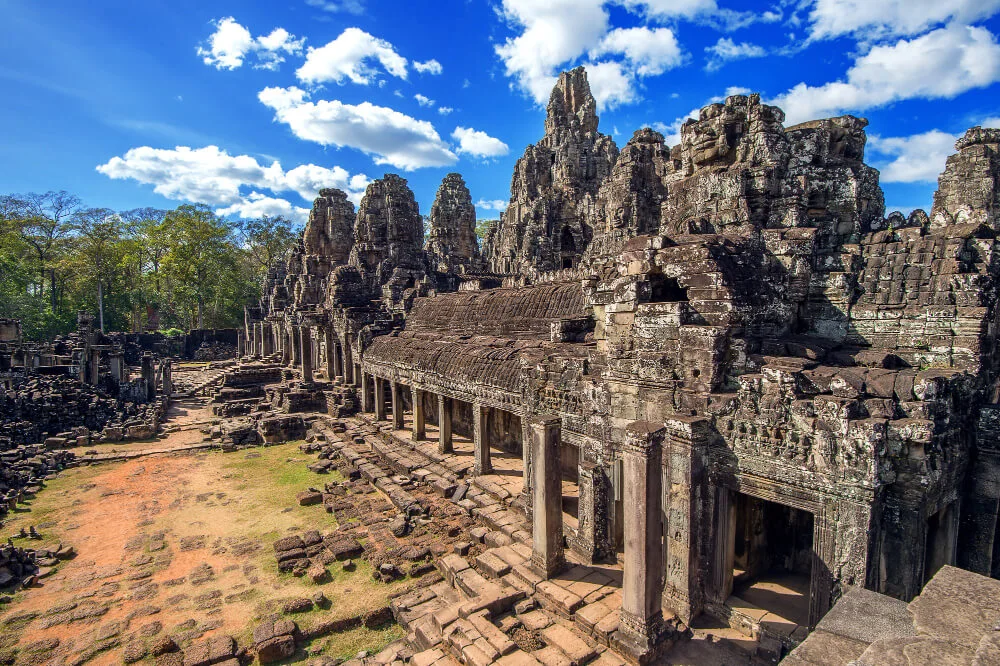
Updated On: March 29, 2024 by Yasmin Elwan
Nestled within the jungles of Siem Reap, Cambodia, the Temples of Angkor stand as a testament to a once-mighty civilisation. These ancient ruins are not merely remnants of stone; they are the soul of the Khmer Empire, whispering tales of glory and devotion. Encompassing the famed Angkor Wat, the mysterious Bayon with its enigmatic stone faces, and the tree-root entwined Ta Prohm, this archaeological park spans over 400 square kilometres and offers a window into the past.
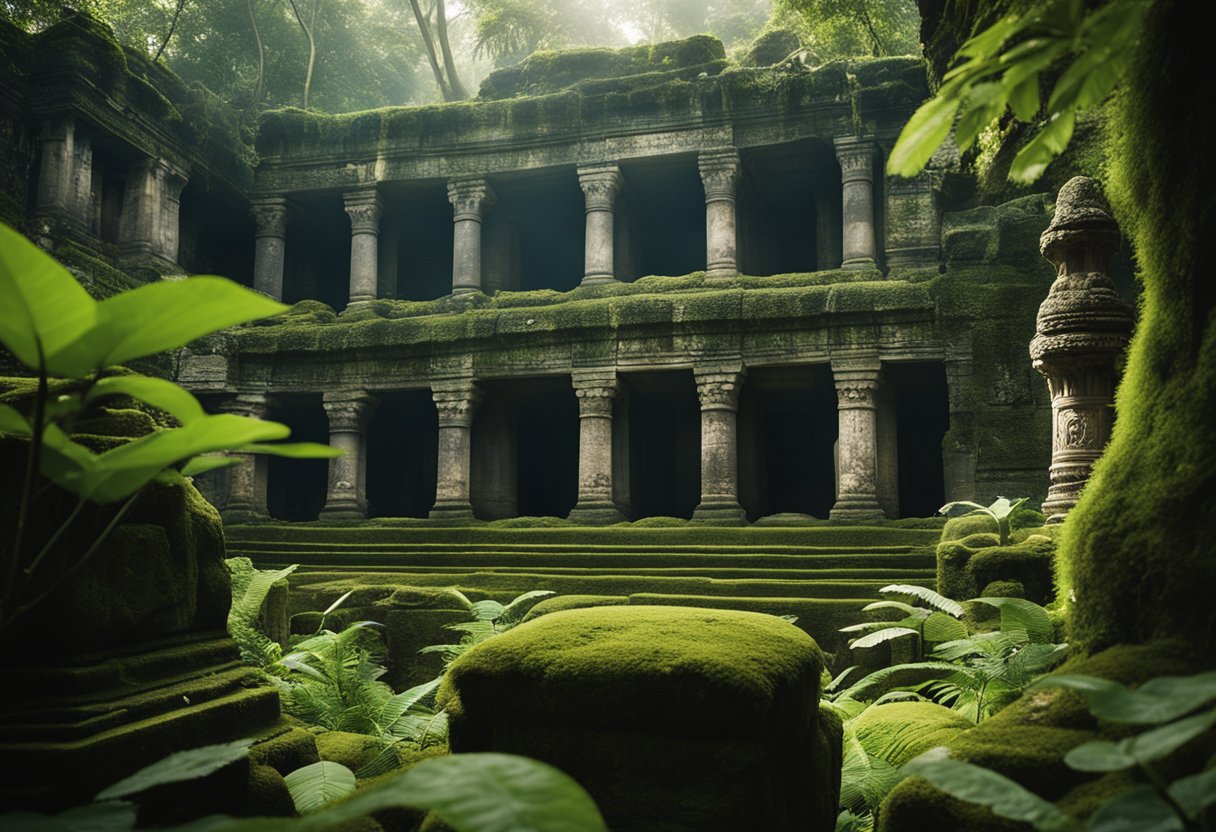
The allure of Angkor lies in its ability to transport visitors back in time. From the intricate bas-reliefs depicting Hindu and Buddhist legends to the grandeur of its towering structures, each temple narrates a different chapter of history. Despite centuries of weathering, the artistry and architecture continue to draw visitors from around the globe, embedding its cultural significance deeply within the heart of Cambodia. As the largest religious monument in the world, Angkor Wat dominates the landscape, but the entire complex tells a deeper story of life, worship, and the sophistication of ancient urban planning.
Historical Context of Angkor
The Temples of Angkor are a testament to the grandeur of the Khmer Empire, reflecting both the empire’s immense power and the religious transformations that took place over centuries. They stand today as a significant reminder of Cambodia’s historical and cultural legacy.
The Rise of the Khmer Empire
We can trace the Khmer Empire’s origins to the early 9th century when it emerged as a dominant power in Southeast Asia. The empire was known for its sophisticated hydraulic engineering, monumental architecture, and intricate art. Historians note it as a period when Cambodia was at the zenith of its political and social influence in the region. The establishment of Angkor as the capital marked the start of a flourishing era for the Khmer civilization.
Significance of the 12th Century
Certainly, the 12th century was pivotal in Angkor’s history. It marked the reign of King Suryavarman II, renowned for commissioning the magnificent Angkor Wat temple. Not only a religious centre, this structure also served a political purpose, reinforcing the king’s divine authority. The vast size and complexity of the temples built during this century are indicative of the empire’s wealth and organisational capabilities.
Hindu and Buddhist Influences
Initially, Hinduism played a central role, with temples like Angkor Wat being dedicated to Vishnu and reflecting stories from Hindu mythology. However, during the latter part of the Khmer Empire, Buddhist influence grew, reflecting the religious dynamism of the era. Temples seamlessly integrated both Hindu and Buddhist motifs, illustrating the civilisation’s religious evolution over time. This blend of influences is evident in the iconography and inscriptions found throughout the archaeological site, now protected by UNESCO.
Exploring Angkor Wat
As we explore the Angkor Wat temple, we’re greeted by a stunning array of architectural intricacies and a deep sense of spiritual resonance with Hindu cosmology.
Architectural Marvels
The temple complex of Angkor Wat is a testament to the architectural genius of the Khmer Empire. Built mainly from sandstone blocks, the intricate layout comprises a series of galleries, courtyards, and cruciform terraces. The main temple replicates the five peaks of Mount Meru, the home of the gods, with its central tower rising majestically above the others. A massive rectangular moat encircles the complex, adding to the grandeur and reflecting the structure during sunset, creating an image of otherworldly peace and symmetry.
Mount Meru and Cosmology
Angkor Wat’s design is heavily influenced by Hindu cosmology, embodying a physical representation of Mount Meru. This sacred mountain is considered the axis of the universe in Hindu mythology. The concentric galleries symbolise the mountain’s surrounding ranges, while the moat represents the cosmic oceans beyond. Strolling through the temple is like walking through a three-dimensional mandala, each pathway and stairway guiding us towards the centre of the universe.
The Vishnu Connection
Dedicated primarily to the Hindu deity Vishnu, Angkor Wat stands out among other temples in the region. Often called a monument to Vishnu, it breaks from Shaivite tradition, which was prevalent during the time of its construction. The walls are alive with bas-reliefs depicting scenes from Hindu epics, including the Churning of the Ocean of Milk. Numerous divine figures, such as apsaras and deities, cover the walls, each meticulously carved from sandstone, enabling us to receive a glimpse into the religious significance and devotion that went into creating this architectural marvel.
Each step through Angkor Wat allows us to embrace not only the physical beauty of the temple but also connects us with a rich, spiritual past where reverence for the gods and cosmic order shaped the very ground on which we walk.
The Wonders of Ta Prohm and Bayon
Within the Angkor complex lies two of the most iconic temples that have intrigued visitors for centuries: Ta Prohm and Bayon. These majestic structures are remarkable for the way they have merged with the jungle and for their enigmatic architectural features.
Nature’s Embrace
Ta Prohm stands as a prime example of what we lovingly call a ‘jungle temple’. The massive strangler figs and kapok trees have woven themselves into the temple’s fabric, both sustaining and destroying the ruins. This natural phenomenon creates a hauntingly beautiful fusion where nature’s embrace asserts itself upon the works of man. Moss-covered stones and the interplay of roots and towers offer tourists a visceral reminder of the powerful forces of nature reclaiming its territory.
Bayon’s Mysterious Faces
Venture further into the heart of Angkor Thom, and you’ll find Bayon, famous for its mysterious faces. Each tower features a series of serene and smiling stone faces, creating a profound and enigmatic presence. Observers often interpret these faces as reflecting the omnipresence of King Jayavarman VII, serving as a symbolic representation of compassion and wisdom. Walking amidst Bayon’s complex design of passageways and galleries, the sense of mystery deepens as one contemplates the history and symbolism behind each intricately carved face.
Daily Life and Religion
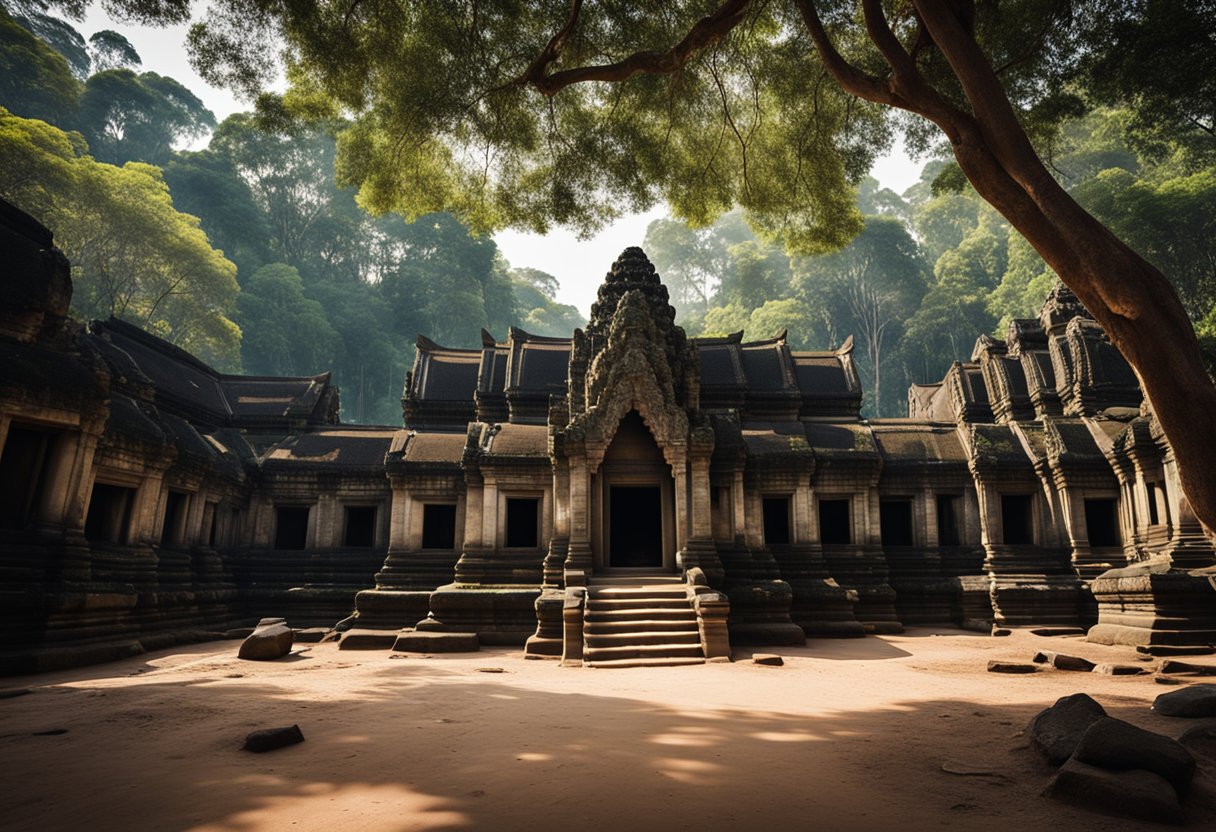
In the shadows of the ancient Angkor temples, the daily life and religious practices of the Khmer people were deeply intertwined. Our insights delve into the significance of these monumental structures and the transcendent shift in spiritual allegiance.
The Role of Temples in Society
The temples of Angkor, beyond their grandeur, served as the epicentre of our daily life and religious activities. These were not merely places of worship; they were the heart of our cities. Majestic structures like Angkor Wat mirrored the universe in stone, illustrating tales of Hindu gods such as Shiva and Brahma. For us, the temples were more than sacred spaces; they were a potent symbol of royal divinity and power, connecting the mortal and celestial realms.
Our society revolved around these temples, with local communities engaged in supporting the religious elite and maintaining the vast complexes. The surrounding landscape, dotted with rice paddies and reservoirs, was expertly managed to sustain our growing populations and support elaborate religious ceremonies.
From Hinduism to Buddhism
Religious allegiance within our society transitioned over time; initially rooted in Hindu beliefs, it gradually adopted Buddhism. This transformation is evident in the iconography of the Angkor temples, where you can observe a palimpsest of Hindu and Buddhist symbols. Buddhist monasteries began to appear alongside the traditional Hindu sanctuaries, signalling a shift that would weave Buddhism into the very fabric of our daily lives.
Angkor Wat itself, originally dedicated to Vishnu, later transformed into a Buddhist temple, reflecting the broader religious evolution. Throughout these transitions, the importance of the temples remained undiminished; they continued to serve as crucial centres for education, cultural preservation, and community cohesion for us.
Tourism and Cultural Significance
The Temples of Angkor are not only an archaeological wonder but also a beacon for tourists worldwide, representing a crucial aspect of Cambodia’s cultural heritage.
Angkor Today
Angkor attracts millions of tourists annually, drawn to witness the splendour of its ancient temples. The journey to Angkor is facilitated by a multitude of guides, tuk tuks, and private cars, ready to navigate the crowds that gather, especially during sunrise at Angkor Wat. Sustainable Tourism and Preservation
The commitment to sustainability and preservation of this UNESCO World Heritage site has become integral for both locals and the global community. Efforts are concentrated on reducing the environmental impact of tourism while ensuring that the local customs and archaeological sites are respected. Tourists are encouraged to follow guidelines that promote responsible tourism, such as supporting local businesses and minimising waste.
Artistry and Iconography
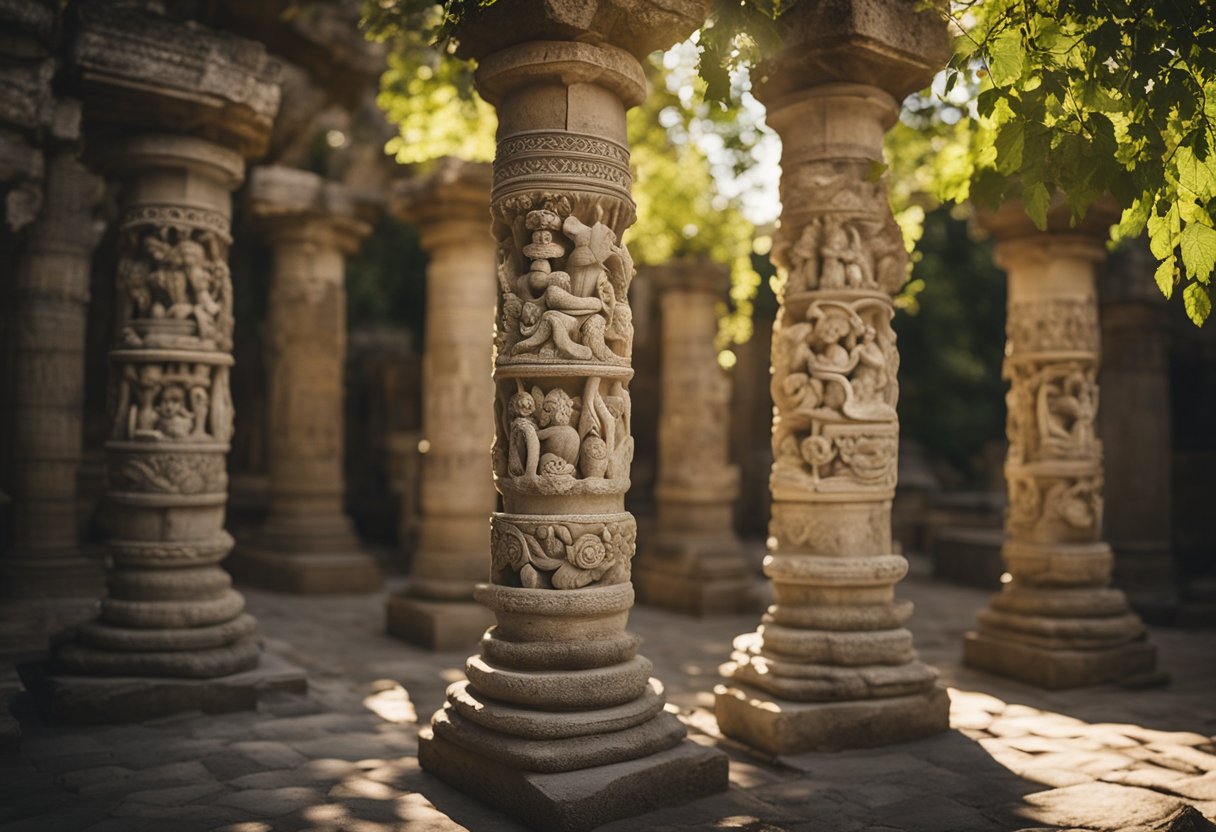
The Temples of Angkor are a testament to the exquisite craftsmanship and rich iconography of the Khmer Empire. Emerging from the dense jungle, these structures reveal a world where artistry served both aesthetic and spiritual purposes.
Apsaras and Devatas
In the galleries of the Angkor temples, apsaras—celestial nymphs—and devatas—minor deities or guardian spirits—are intricately carved into the walls. These figures are emblematic of the temples’ deeper connection to Hindu mythology, each one uniquely rendered with a poise and grace that seems to capture a moment in time. The depiction of apsaras, in particular, is abundant, representing not only ethereal beauty but also the connection between the divine and mortal realms.
Mythological Depictions
Mythology pervades the stone reliefs that adorn the ancient architecture. Deities from Hindu mythology are prominently featured throughout, including the revered god Vishnu, whom the iconic Angkor Wat is dedicated to. The galleries often narrate famous episodes from Hindu epics like the Ramayana and the Mahabharata, as well as the cosmic battles between deities and demons. Through these depictions, visitors gain insight into the religious beliefs and the artistic expressions of the Khmer people.
The Fall and Rediscovery
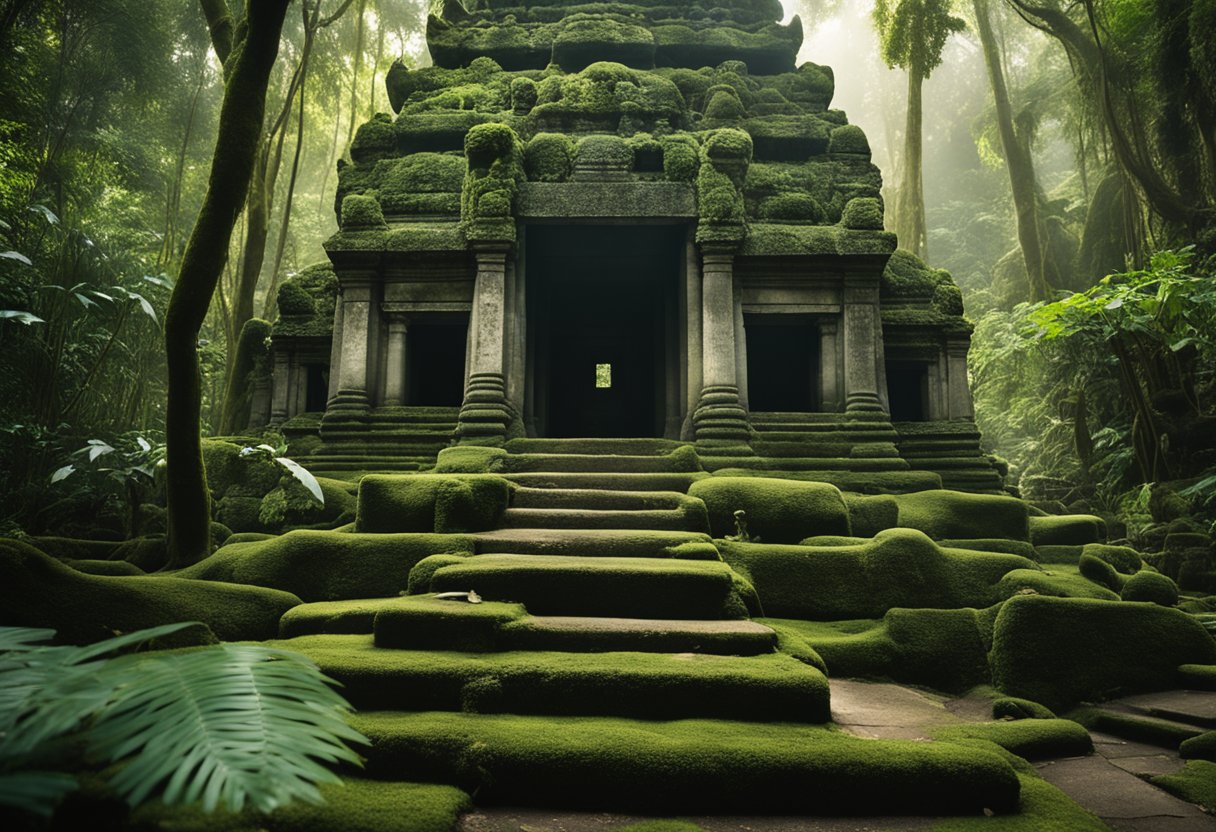
Before we uncover the enigmatic tapestry of Angkor’s history, we must understand the pivotal chapters that marked its decline and eventual rediscovery. These moments are critical in comprehending how a once-flourishing civilisation could slip into the shadows of the jungle, only to be reintroduced to the world centuries later.
Invasions and Decline
The decline of Angkor, while intricately complex, can largely be attributed to invasions and internal strife. Historians pinpoint the 15th century as a significant period when the Khmer Empire began to wane, brought on by a series of invaders, including the Siamese and Cham. These incursions not only disrupted the social order but also strained the empire’s resources and weakened its grasp on the region. The fall of Angkor was not an overnight occurrence; rather, it was a prolonged decline that culminated in the abandonment of the urban centre, which was once the heart of their civilisation.
Angkor in Modern Times
In more recent times, the temples of Angkor have been ushered back onto the world stage, lobbying for a dramatic, if not cinematic, revival. It’s no plot from an Indiana Jones film, but the UNESCO World Heritage designation has played a vital role in Angkor’s modern narrative. This illustrious title, coupled with global interest spearheaded by historians and archaeologists, has seen Angkor emerge from its long slumber. Reconceived not as ruins but as relics of human ingenuity amidst the Cambodian jungle, Angkor’s temples stand as a testament to the grandeur of the Khmer Empire and an enduring symbol of Cambodia’s cultural heritage.
Through our journey, we’ve observed the layers of history that Angkor has both concealed and revealed. We endeavour to understand the complex tale of this archaeological marvel, ensuring that our steps towards preserving and interpreting this site remain diligent and respectful of its storied past.
Conservation Efforts
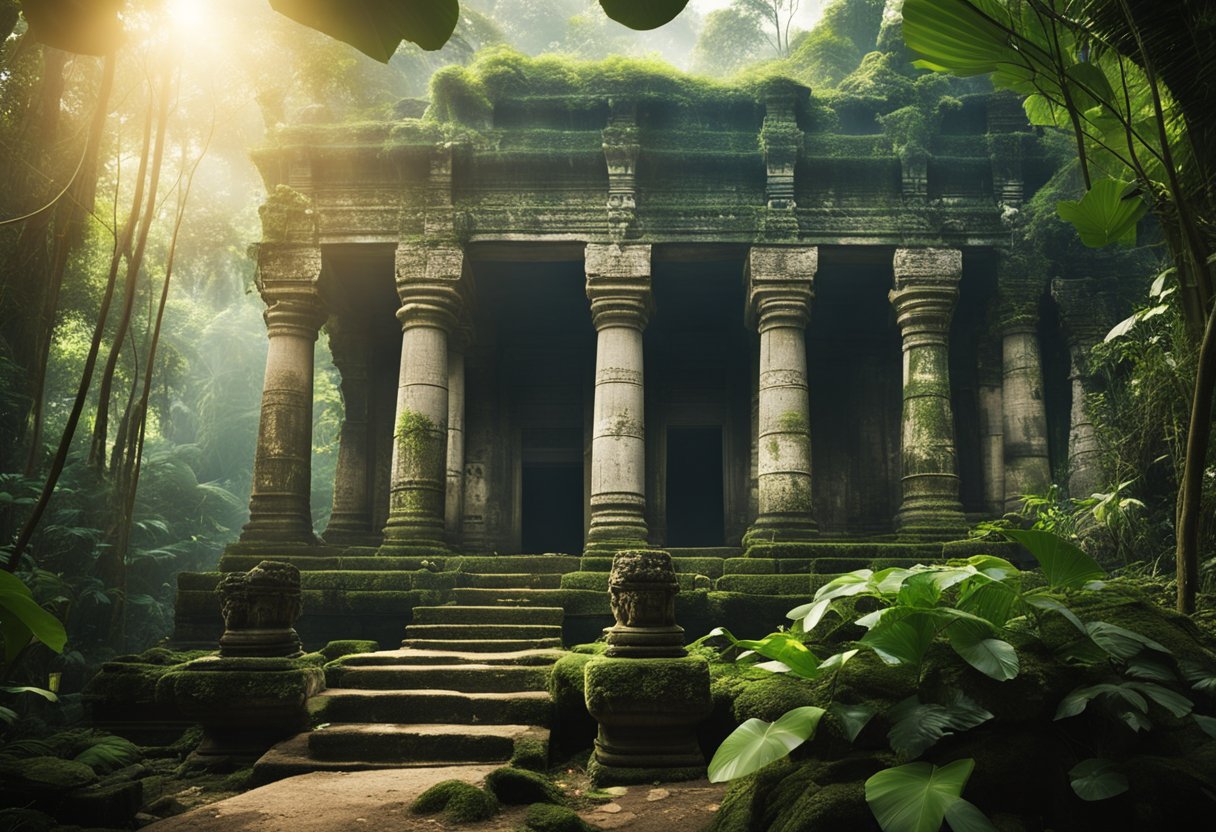
In our examination of the Temples of Angkor, one critical aspect stands out – the concerted efforts to preserve this monumental heritage site. Ensuring the longevity of such an iconic testament to South East Asia’s history involves overcoming complex challenges while securing international support.
Restoration Challenges
The Angkor Archaeological Park is a living museum home to an intricate history and delicate balance between nature and architecture. Conservation efforts are frequently hampered by the tropical climate, which accelerates the deterioration of the ancient structures. In the 1970s, the civil war in Cambodia further impeded restoration activities at the site, resulting in the suspension of conservation work.
The encroachment of vegetation, particularly the ubiquitous silk-cotton and strangler fig trees, presents a constant battle, where intrusive roots both support and damage the centuries-old stonework. Balancing the need to maintain the site’s character and the imperative to prevent further erosion is an ongoing challenge for conservators.
International Aid and Support
UNESCO designated Angkor as a World Heritage site in 1992, recognising both its cultural significance and the urgent need for preservation. This status has catalysed international aid and support, bringing together a coalition of global partners committed to safeguarding this historical treasure. Organisations like the World Monuments Fund have made notable contributions by collaborating on numerous projects aimed at stabilising structures and restoring artistry. International efforts not only bring much-needed financial assistance but also expertise in leading-edge restoration techniques essential for the methodical rehabilitation of the temples. Through the cooperation of global communities, Angkor continues to stand as a testament to our shared heritage in South East Asia.
Notable Temples and Structures
Amidst the dense Cambodian jungle lie architectural marvels that have withstood the test of time; they are testament not just to spiritual devotion but also to the grandeur of the Khmer Empire. We journey through a few of their majestic forms.
Banteay Srei’s Intricate Carvings
When we wander through the temple of Banteay Srei, the sheer intricacy of the carvings that adorn the red sandstone walls captivates us. This 10th-century monument, often referred to as the ‘Jewel of Khmer Art,’ showcases some of the finest examples of classical Khmer architecture.
Preah Khan’s Grandeur
The temple of Preah Khan, once a bustling city and a place of scholarship, now stands partly clad by the roots of the jungle. However, its unrestored state only adds to the grandeur of this late 12th-century complex, where corridors lead to stunning courtyards and inner sanctums once roamed by monks and royals alike.
The Enigma of Beng Mealea
An atmosphere of mystery pervades Beng Mealea, a temple complex more remote and less frequented by tourists. This sprawling, largely unrestored site invites us to imagine its past splendour, allowing us to piece together the history hidden amidst the fallen stones and overgrowth that have reclaimed this ancient edifice.
Infrastructure and Urban Planning
Exploring the ancient city of Angkor reveals an advanced level of infrastructure and urban planning, which played a pivotal role in supporting a large population and ensuring the functionality of the city.
Water Management Systems
Angkor’s water management systems exemplified a sophisticated approach to controlling water for agriculture and urban sustenance. The Khmer rulers engineered an expansive network of canals, dykes, and reservoirs—known as barays—that facilitated irrigation across the region. These systems allowed for rice cultivation, which supported a burgeoning population and underscored the prosperity of the Kingdom.
City Layout and Connectivity
The layout of Angkor was characterised by a grid-like pattern of roads and canals, showcasing an extraordinary understanding of urban connectivity. A dominant feature was the centralisation of temples, such as the renowned Angkor Wat, suggesting that spiritual and administrative functions were intricately linked.
Researchers have disclosed that the low-density urban sprawl was made coherent through large-scale infrastructure, binding the residential and agricultural areas into a singular corporate entity. Greater Angkor, as this entity was known, demonstrated advanced urban planning, with its infrastructure facilitating access throughout the city and shaping its development over time.
Legends and Influence on Popular Culture
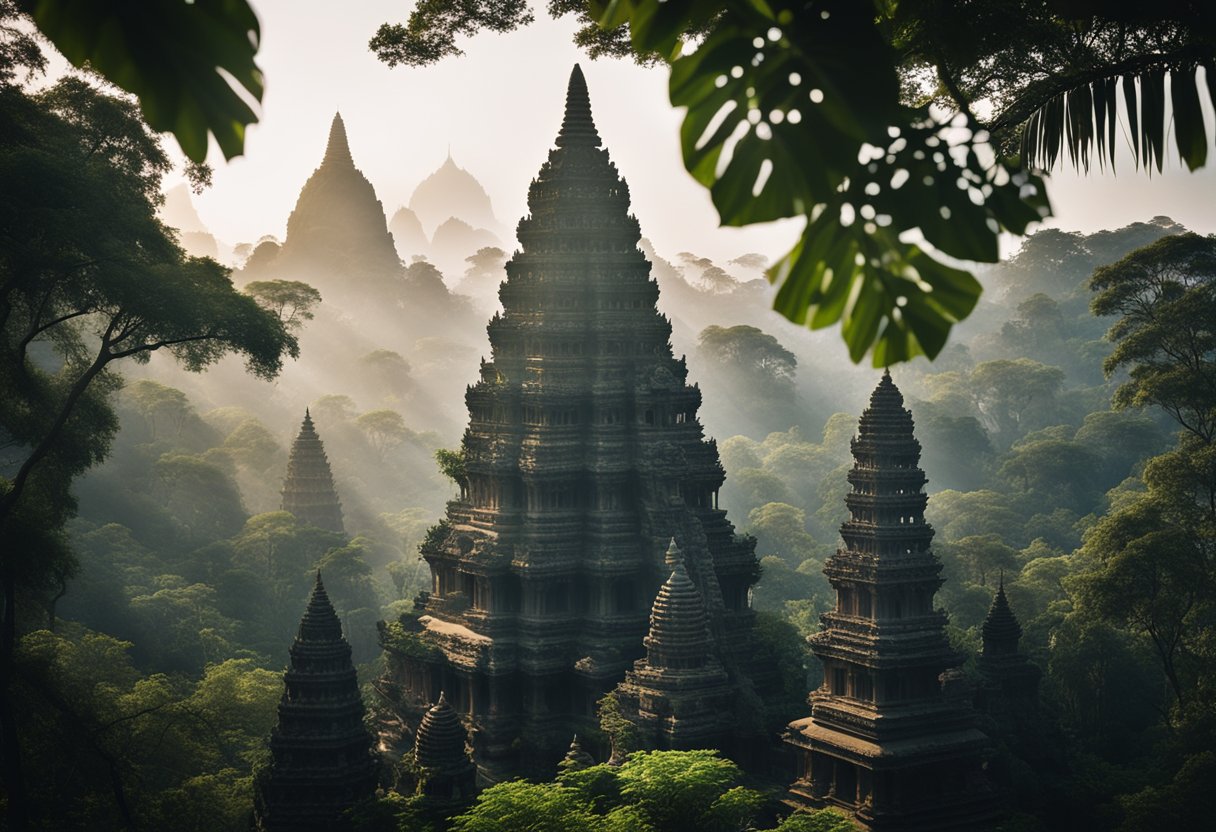
The Temples of Angkor have not only been a subject of historical significance but also a wellspring of inspiration for various artistic works, embedding themselves deeply into the collective imagination and popular culture.
Angkor in Literature and Film
Angkor’s mystical allure has transcended time, finding its way into the realms of literature and film. We witness the adventurous spirit of the temple complex portrayed in the 2001 film Tomb Raider, where the intrepid protagonist Lara Croft, played by Angelina Jolie, explores the eerie ruins of Angkor Thom. The film’s depiction of the temple as both a cultural marvel and a backdrop for action has significantly bolstered its recognition worldwide. Much like Indiana Jones, the cinematic presentation of these ancient ruins stirs a sense of adventure and curiosity, cementing the temples in the fabric of popular culture.
Tales and Mythology
Embedded within the walls and carvings of the temples are centuries of Hindu mythology and local legends. These tales are not just relics of the past but continue to resonate with the religious and cultural essence of the region. Stories of deities and historical figures are intricately depicted in the bas-reliefs adorning the temple walls, offering a narrative as complex and captivating as the temples themselves. The legend of the construction of Angkor Wat, which weaves together both religious belief and the might of the Khmer Empire, remains one of the intriguing tales that attract scholars and spiritual seekers alike.
Frequently Asked Questions

In this section, we address common queries about the monuments’ history, design, and ongoing enigmas.
What is the significance of the Angkor Wat temple’s architectural design?
The architectural design of Angkor Wat temple is emblematic of cosmic symbolism in Hindu architecture. The temple complex mirrors the Hindu cosmology, with the central towers representing Mount Meru, the home of the gods. Its five towers correspond to the peaks of Meru, while the moat and enclosure walls represent the mountains and ocean in the creation myth.
How did the Khmer Empire contribute to the construction of the temples at Angkor?
The Khmer Empire oversaw the temple constructions at Angkor, utilising an extensive workforce and sophisticated hydraulic engineering. Kings of the empire, such as Suryavarman II and Jayavarman VII, were central to the development, dedicating these structures to various deities and showcasing the empire’s wealth and cultural sophistication.
What hidden structures have been revealed in the Cambodian jungle near Angkor?
Recent archaeological discoveries near Angkor have unveiled hidden city and temple foundations through techniques like airborne laser scanning (LiDAR). These structures hint at a vast, complex urban network, indicating Angkor was possibly the largest pre-industrial city on Earth.
In what ways did Angkorian kings impact the development of temple architecture?
Angkorian kings significantly impacted temple architecture through personalised modifications and distinctive styles. Temples like Bayon, with its serene stone faces, reflect the Mahayana Buddhist influence during Jayavarman VII’s reign, a distinct shift from the previously dominant Hinduism.
What are the unsolved mysteries surrounding the temples of Angkor?
The temples of Angkor hold many unsolved mysteries, from the function of enigmatic structural features to the unknown reasons behind the civilisation’s decline and eventual desertion. Ongoing research continues to unearth new insights, yet many secrets remain locked in the ancient stone.
How does the Angkor Wat temple reflect the spiritual beliefs of the Khmer civilisation?
Angkor Wat temple reflects spiritual beliefs through its depictions of Hindu mythology and its alignment with astronomical events, such as the equinoxes. This intricacy highlights the Khmer’s reverence for divine kingship and the cosmos, which are central to their spiritual life.
Our exploration of these questions reveals the complex tapestry of history and devotion woven into the stones of Angkor. We continue to seek an understanding of this splendid chapter of human endeavour nestled within the Cambodian jungle.






